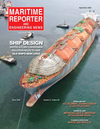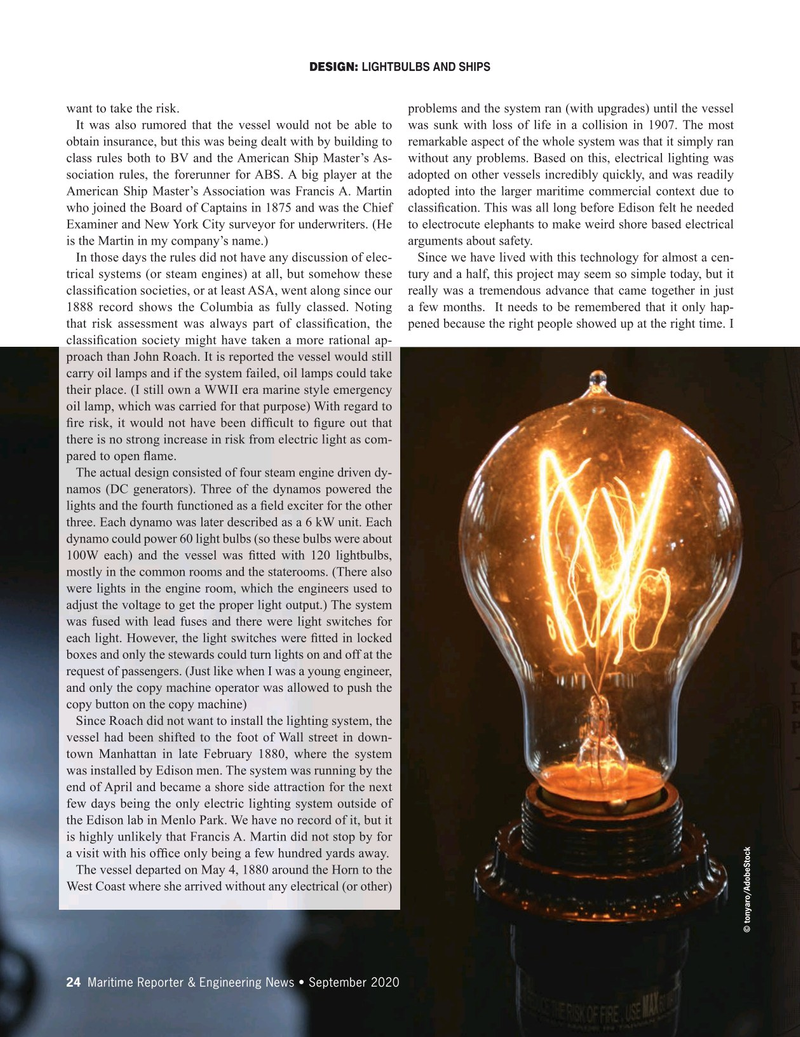
Page 24: of Maritime Reporter Magazine (September 2020)
Marine Design Annual
Read this page in Pdf, Flash or Html5 edition of September 2020 Maritime Reporter Magazine
DESIGN: LIGHTBULBS AND SHIPS want to take the risk. problems and the system ran (with upgrades) until the vessel
It was also rumored that the vessel would not be able to was sunk with loss of life in a collision in 1907. The most obtain insurance, but this was being dealt with by building to remarkable aspect of the whole system was that it simply ran class rules both to BV and the American Ship Master’s As- without any problems. Based on this, electrical lighting was sociation rules, the forerunner for ABS. A big player at the adopted on other vessels incredibly quickly, and was readily
American Ship Master’s Association was Francis A. Martin adopted into the larger maritime commercial context due to who joined the Board of Captains in 1875 and was the Chief classi? cation. This was all long before Edison felt he needed
Examiner and New York City surveyor for underwriters. (He to electrocute elephants to make weird shore based electrical is the Martin in my company’s name.) arguments about safety.
In those days the rules did not have any discussion of elec- Since we have lived with this technology for almost a cen- trical systems (or steam engines) at all, but somehow these tury and a half, this project may seem so simple today, but it classi? cation societies, or at least ASA, went along since our really was a tremendous advance that came together in just 1888 record shows the Columbia as fully classed. Noting a few months. It needs to be remembered that it only hap- that risk assessment was always part of classi? cation, the pened because the right people showed up at the right time. I classi? cation society might have taken a more rational ap- proach than John Roach. It is reported the vessel would still carry oil lamps and if the system failed, oil lamps could take their place. (I still own a WWII era marine style emergency oil lamp, which was carried for that purpose) With regard to ? re risk, it would not have been dif? cult to ? gure out that there is no strong increase in risk from electric light as com- pared to open ? ame.
The actual design consisted of four steam engine driven dy- namos (DC generators). Three of the dynamos powered the lights and the fourth functioned as a ? eld exciter for the other three. Each dynamo was later described as a 6 kW unit. Each dynamo could power 60 light bulbs (so these bulbs were about 100W each) and the vessel was ? tted with 120 lightbulbs, mostly in the common rooms and the staterooms. (There also were lights in the engine room, which the engineers used to adjust the voltage to get the proper light output.) The system was fused with lead fuses and there were light switches for each light. However, the light switches were ? tted in locked boxes and only the stewards could turn lights on and off at the request of passengers. (Just like when I was a young engineer, and only the copy machine operator was allowed to push the copy button on the copy machine)
Since Roach did not want to install the lighting system, the vessel had been shifted to the foot of Wall street in down- town Manhattan in late February 1880, where the system was installed by Edison men. The system was running by the end of April and became a shore side attraction for the next few days being the only electric lighting system outside of the Edison lab in Menlo Park. We have no record of it, but it is highly unlikely that Francis A. Martin did not stop by for a visit with his of? ce only being a few hundred yards away.
The vessel departed on May 4, 1880 around the Horn to the
West Coast where she arrived without any electrical (or other) © tonyaro/AdobeStock 24 Maritime Reporter & Engineering News • September 2020
MR #9 (18-33).indd 24 9/9/2020 8:10:25 AM

 23
23

 25
25
